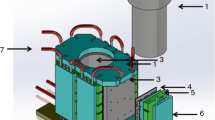Abstract
The problem of estimating the residual usable energy of a lead-acid cell has been intensified by the introduction of fully sealed units. These rely on the recombination of gaseous oxygen produced during overcharge at the positive electrode with the active material at the negative electrode. This introduction has removed the possibility of electrolyte density measurements, third electrode measurements and restricted residual capacity assessments to the two cell terminals. A method for this process is described using a parameter based on a characteristic frequency. The parameter is also a useful measure of cell ageing.
Similar content being viewed by others
Abbreviations
- R SOL :
-
Ohmic resistance of cell (Ω)
- θ:
-
Charge-transfer resistance of positive and negative electrodes (Ω)
- CL :
-
Double-layer capacitance of both positive and negative electrodes (F)
- σ:
-
Warburg diffusion (ΩS−1/2)
- C EXT :
-
External series capacitor in analogue Fig. 5 (F)
- R EXT :
-
External resistor in parallel withC EXT in the anologue circuit Fig. 5 (Ω)
- IND :
-
Inductor in Fig. 5 representing the geometrical effects of the cell at high frequencies (Henries)
- R IND :
-
External resistor in parallel with IND in the analogue circuit Fig. 5 (Ω)
- λ:
-
Roughness factor allowing for the porosity of both electrodes
References
S. A. G. R. Karunathilaka, N. A. Hampson and R. Leek,Surface Technol. 13 (1981) 339.
N. A. Hampson, S. A. G. R. Karunathilaka and R. Leek,J. Appl. Electrochem. 10 (1980) 3.
S. A. G. R. Karunathilaka, N. A. Hampson, T. P. Hass, R. Leek, T. J. Sinclair, ——Ibid.11 (1981) 573.
M. Hughes, R. T. Barton, S. A. G. R. Karunathilaka, N. A. Hampson and R. Leek ——ibid.15 (1985) 129.
W. G. Marshall, R. Leek, N. A. Hampson and G. Lovelock,J. Power Sources 13 (1984) 75.
S. A. G. R. Karunathilaka, R. T. Barton, M. Hughes and N. A. Hampson,J. Appl. Electrochem. 15 (1985) 251.
J. Bialacki, N. A. Hampson and J. Pearson,Surface Technol. 23 (1984) 117.
N. A. Hampson, S. Kelly and K. Peters,J. Appl. Electrochem. 11 (1981) 751.
S. Cotgreave, N. A. Hampson and S. A. G. R. Karunathilaka, Interim Report to MoD Contract No. ER/a/9/4/2170.095/RSRE.
N. A. Hampson and M. J. Willars,Surface Technol. 7 (1978) 247.
R. de Levie in “Advances in Electrochemical Engineering” Vol. 6, edited by P. Delahay, Interscience, New York (1967) p. 329.
H. A. Laitinen and J. E. B. Randles,Trans. Faraday. Soc. 51 (1955) 54.
S. Kelly, N. A. Hampson and S. A. G. R. Karunathilaka,Surface Technol. 13 (1981) 349.
Author information
Authors and Affiliations
Rights and permissions
About this article
Cite this article
Hughes, M., Barton, R.T., Karunathilaka, S.A.G.R. et al. The estimation of the residual capacity of sealed lead-acid cells using the impedance technique. J Appl Electrochem 16, 555–564 (1986). https://doi.org/10.1007/BF01006850
Received:
Revised:
Issue Date:
DOI: https://doi.org/10.1007/BF01006850




